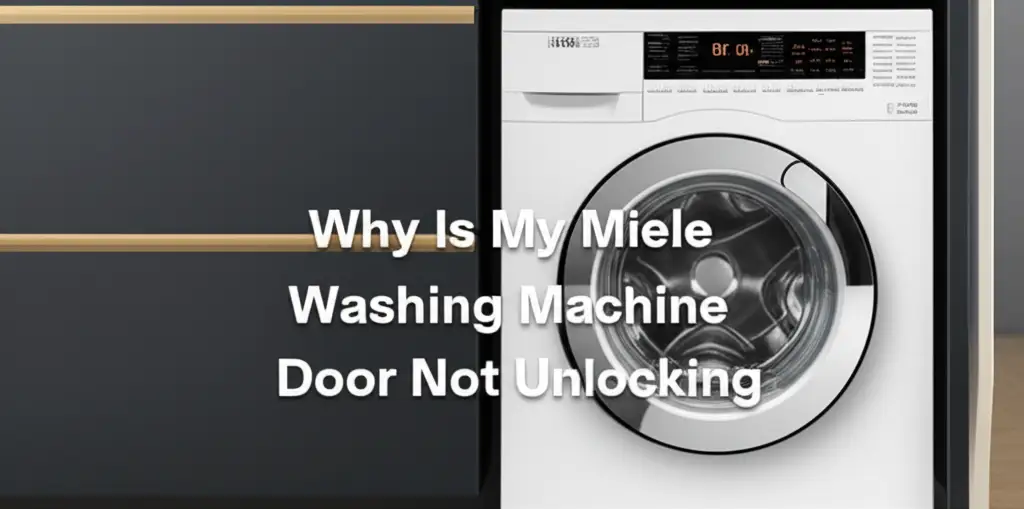· Todd Martin · Home Appliance Repair · 21 min read
Repair Your LG Washer Door Handle

Repair Your LG Washer Door Handle
Has your LG washing machine door handle broken? It is frustrating when a vital part of your appliance stops working. A broken handle makes it hard to open or close the washer door. This issue can disrupt your laundry routine. Do not worry, you do not need to buy a new machine. Replacing the door handle on your LG washing machine is a task you can do yourself. This guide provides clear, simple steps to help you. I will walk you through finding the right part, gathering tools, and performing the repair. By the end, your LG washing machine will work properly again.
Takeaway
- Identify the exact LG washing machine model and handle part number.
- Gather necessary tools like screwdrivers, pliers, and a trim removal tool.
- Always disconnect power to the washing machine before starting work.
- Carefully remove the old handle by unscrewing or unlatching components.
- Install the new handle by reversing the removal steps, ensuring it fits correctly.
- Test the new handle and door latch for proper function after reassembly.
Replacing an LG washing machine door handle involves simple steps: disconnect power, access the handle by removing the door panel or trim, unscrew or unclip the old handle, then install the new handle in reverse order, and reassemble the door.
Understanding Your LG Washing Machine Handle
A washing machine door handle endures a lot of use. Each time you load or unload laundry, you pull on it. Over time, this repeated stress can cause the handle to crack or break. LG washing machines, like other brands, use specific handle designs. Understanding why handles break helps prevent future issues. It also prepares you for the replacement process.
Handles often break due to fatigue. The plastic or metal material weakens with constant pulling. Sometimes, a sudden forceful pull can snap it. Misalignment of the door latch can also put extra stress on the handle. When the handle breaks, the door may not open at all. In some cases, it might remain stuck shut. This makes laundry impossible. You need to fix it quickly.
Identifying your specific LG washing machine model is the first step. Look for a label on the machine. This label is usually inside the door frame or on the back. It lists the model number and serial number. This information is critical for ordering the correct replacement handle. LG has many models, and handles are not universal. A front-load washer handle differs from a top-load lid handle. Even within front-load models, designs vary. Getting the right part ensures a successful repair.
You might wonder if you can open a broken washer door. If your handle is broken, but the latch still works, you might be able to. Some washing machines allow manual latch release. This depends on the specific model. For some brands, a string or lever inside the machine can release the door. Learning about how to open a Beko washing machine door with a broken handle can offer insights into similar mechanisms in other washers. Knowing this can help you retrieve your clothes before the repair.
Once you have your model number, search for the part online. Many appliance parts websites carry LG replacement handles. You can also contact LG customer support or a local appliance parts store. They can help you find the exact part you need. Always double-check the part number. Compare it with your old handle if possible. This prevents ordering the wrong item. Getting the correct part saves time and effort.
Gathering Tools and Your New LG Washing Machine Handle
Before you begin any repair work, you need the right tools. Having everything ready beforehand makes the process smooth. It saves you trips to the hardware store. Most of the tools required are common household items. You might already own them. Take a moment to collect them all in one place.
Here is a list of tools you will likely need:
- Screwdrivers: You will need both Phillips head and flathead screwdrivers. Sizes vary, so have a set handy.
- Pliers: Needle-nose pliers can be useful for gripping small parts or wires.
- Nut Driver or Socket Set: Some LG models use nuts or bolts instead of screws.
- Trim Removal Tool or Putty Knife: This helps pry open plastic panels without causing damage.
- Work Gloves: Protect your hands from sharp edges or pinch points.
- Small Container: For holding screws and small parts, so they do not get lost.
- New LG Washing Machine Door Handle: Ensure this is the correct part for your model.
- Flashlight or Headlamp: To illuminate tight or dark areas inside the door.
Your replacement handle is the most important item. As I mentioned earlier, make sure it matches your LG washer model. Check the part number again before you start. An incorrect part will not fit. This leads to frustration and delays. Many online retailers provide diagrams. These diagrams show where each part goes. This helps confirm you have the right one.
When you purchase the new handle, inspect it. Look for any visible damage. Ensure all necessary pins, springs, or screws come with it. Sometimes, parts kits include these. Other times, you may need to reuse existing hardware. Knowing this beforehand helps avoid surprises. Most new handles come ready for installation.
This type of repair is a good example of a do-it-yourself washing machine project. It empowers you to fix common issues without calling a professional. This saves money on labor costs. Plus, you learn more about your appliance. This knowledge can be useful for future maintenance or repairs. Knowing your way around your washing machine can save you money and headaches in the long run.
Having a clean, well-lit workspace is also important. Clear the area around your washing machine. This gives you room to work comfortably. Place a towel or blanket on the floor if you plan to lay the door down. This protects both the door and your flooring. Organized tools and a clear workspace make the repair much easier.
Safety First: Preparing for LG Washing Machine Repair
Before touching any appliance for repair, safety must be your top priority. Washing machines use electricity and water. Ignoring safety steps can lead to serious injury or damage. I always stress the importance of disconnecting power. This prevents accidental shocks. It also stops the machine from starting during your work.
Here are the essential safety steps:
- Unplug the Washing Machine: Locate the power cord. It connects to an electrical outlet. Pull the plug directly from the outlet. Do not just turn the machine off. The main switch may not fully cut power to all components. Ensure the plug is completely removed. This isolates the machine from the electrical supply.
- Turn Off Water Supply: Washing machines connect to hot and cold water lines. Find the two hoses attached to the back of the machine. Follow these hoses to the water valves on your wall. Turn both the hot and cold water valves clockwise until they are fully closed. This prevents any water leaks during the repair. You do not want water spilling everywhere.
- Drain Any Remaining Water (If Applicable): If your washing machine has water inside, you need to drain it. This is usually not necessary for a handle replacement. However, if the door was stuck or the machine stopped mid-cycle, there might be water. Refer to your LG washing machine manual for draining procedures. Some models have a small drain hose near the pump filter at the bottom front. Ensure the machine is completely empty.
- Clear the Work Area: Make sure the space around the washing machine is clear. Remove any laundry baskets, detergents, or other items. This gives you enough room to maneuver. It also prevents tripping hazards. Good lighting is also helpful.
Remember, safety is not an option; it is a requirement. Taking a few extra minutes for preparation saves you from potential hazards. It also makes the repair process safer and more efficient. Do not rush this part.
Once the power is off and water supply is secure, you are ready to proceed. You can now safely work on the washing machine door. Always double-check these steps. It gives you peace of mind during the repair. When you are working on an appliance like a washing machine, it is easy to forget small but crucial details. These safety checks ensure you are fully prepared. This also applies to other washing machine repairs. For example, replacing a Whirlpool washing machine door boot seal also requires similar safety precautions. The principles of appliance repair safety remain constant across different brands and parts.
Step-by-Step Guide: Removing the Old LG Washing Machine Handle
Now that you have prepared the area and ensured safety, you can begin the actual repair. Removing the old, broken handle requires careful steps. The exact method varies slightly between LG models. Most front-load washers have handles integrated into the door assembly. Top-load washers have handles on the lid. I will focus on front-load models, as they commonly experience handle breaks.
1. Open the Washing Machine Door (if possible): If your handle is only partially broken, try to open the door. This gives you better access to the inside components. If the door is stuck, you may need to work with it closed. You might need to gently pry it open slightly if a piece of the handle is jamming the latch.
2. Access the Handle Screws/Mounting Points: The handle is usually secured from the inside of the door panel.
- For front-load washers: You might need to remove the outer or inner door panel.
- Look for screws around the perimeter of the door. These often hold the inner door panel to the outer frame.
- Use your Phillips head or flathead screwdriver to remove these screws. Place them in your small container.
- Carefully pry apart the inner and outer door panels. Use a trim removal tool or a putty knife. Be gentle to avoid scratching or breaking plastic clips. Some models might have clips instead of screws.
- Once the panels separate, you will see the handle mechanism.
- For top-load washers (lid handle): The handle is typically part of the lid assembly. You might need to unscrew hinges or specific handle screws on the lid itself. Access is usually simpler.
3. Disconnect the Latch Mechanism (if applicable): The handle connects to the door latch mechanism. The handle moves a rod or lever that operates the latch.
- Identify how the handle links to the latch. It might be a small rod, a spring, or a cable.
- Carefully disconnect this linkage. Use needle-nose pliers if needed for small parts. Note how it was connected. This helps during reassembly.
4. Remove the Old Handle: Once the panels are separated and the latch linkage is disconnected, you can remove the handle.
- The handle itself might be held by additional screws. Look for these around the base of the handle on the inside of the door.
- Unscrew any remaining screws holding the handle in place.
- Gently pull the old handle away from the door. It might be slightly stiff if it is still partially connected or wedged.
It is helpful to take pictures with your phone at each step. This visual record helps you remember how everything fits together. This is especially useful for complex mechanisms. Working on appliance parts requires attention to detail. This systematic approach ensures you do not miss anything. This meticulous work is similar to when you replace a GE washing machine drain pump. While the specific parts differ, the methodical approach to disassembly remains key. Keep all screws and small parts organized. Losing even one screw can delay your repair.
Installing Your New LG Washing Machine Door Handle
With the old handle removed, you are ready to install the new one. This part of the repair is essentially the reverse of the removal process. However, precision and care are still vital. Make sure the new handle is oriented correctly before you start fastening it.
1. Position the New Handle: Take your new LG washing machine door handle. Carefully align it with the opening on the door. It should fit snugly. Ensure any mounting tabs or screw holes line up perfectly with the door frame. Do not force it into place. If it does not fit, double-check that you have the correct replacement part.
2. Secure the Handle:
- Insert the screws that hold the handle in place. These are typically the same screws you removed from the old handle.
- Tighten these screws firmly but do not overtighten. Overtightening can strip the screw threads or crack the plastic handle. Hand-tight is usually sufficient.
3. Reconnect the Latch Mechanism: This step is crucial for the door to open and close properly.
- Reconnect the rod, spring, or cable from the latch mechanism to the new handle. Refer to your pictures from the disassembly step.
- Ensure the connection is secure. Test the handle’s movement slightly to confirm it engages the latch. You should feel it pull or push the latch mechanism.
4. Reassemble the Door Panels: Once the new handle is securely installed and connected to the latch:
- Carefully bring the inner and outer door panels back together.
- Align the edges and any clips. Press them firmly until they snap into place.
- Insert all the perimeter screws you removed earlier.
- Tighten these screws, again, without overtightening. Ensure the door panels are flush and secure. There should be no gaps.
This process is straightforward when done methodically. It brings your washing machine back to full functionality. This type of fix is common across various appliances. Whether it is a washing machine or even tightening a GE refrigerator door handle without visible screws, understanding how parts connect is key. Patience during assembly helps prevent mistakes. A correctly installed handle will operate smoothly. It will feel solid when you pull it.
Take your time during installation. Double-check each connection and screw. A loose handle or improperly connected latch can lead to future problems. You want this repair to last. After everything is assembled, the door should look just like it did before. It will operate even better with the new handle.
Testing and Maintenance Tips for Your LG Washer
You have successfully replaced the door handle on your LG washing machine. Now, it is time to test your work. Proper testing ensures the repair is complete and safe. It also gives you peace of mind. After testing, consider some simple maintenance tips. These tips can help prolong the life of your new handle and your washing machine.
1. Reconnect Power and Water:
- Go back to the electrical outlet. Plug the washing machine power cord back in firmly.
- Return to the water valves. Slowly turn both the hot and cold water valves counter-clockwise. Open them completely. Listen for any leaks near the hose connections.
2. Test the Door Handle and Latch:
- Attempt to open and close the washing machine door several times.
- The handle should move smoothly. The door should latch securely with a satisfying click.
- Try pulling on the door when it is latched. It should not open easily. This confirms the latch is working correctly.
- If the door does not latch or open properly, something is misaligned. You may need to reopen the door panel. Check the handle-to-latch connection again. Ensure no wires or components are obstructing the latch mechanism.
3. Run a Short Cycle:
- Once the door opens and closes correctly, run a short, empty wash cycle.
- Observe the door during the cycle. Make sure it stays securely closed.
- Listen for any unusual noises coming from the door area.
- Check for any water leaks around the door seal. This step ensures all components work correctly under operational conditions. If you see water, you might need to check the door boot seal. While this link points to a Whirlpool model, the principles of checking for seal leaks are universal.
Maintenance Tips for Your LG Washing Machine Door Handle:
- Avoid Forceful Pulls: Always open the door gently. Avoid yanking or pulling with excessive force. This puts less strain on the handle and latch.
- Keep the Latch Area Clean: Lint, detergent residue, or small foreign objects can accumulate around the latch. This can prevent it from engaging properly. Periodically wipe down the latch area.
- Check for Misalignment: If the door seems difficult to close or latch, check for alignment issues. The hinges might be loose, or the machine might not be level. A misaligned door puts extra stress on the handle.
- Regular Cleaning: Regularly clean your LG washing machine. This includes the door and door seal. This prevents grime buildup that can affect door operation. Learning how to clean an LG HE washing machine can help keep your machine in top condition. A clean machine performs better and experiences fewer issues.
- Educate Others: If others use the washing machine, show them how to open and close the door properly. Gentle handling benefits everyone.
By following these simple steps, your new LG washing machine door handle will serve you well for a long time. You have completed a successful DIY repair. This saves you money and gives you a sense of accomplishment.
Troubleshooting Common LG Washing Machine Door Handle Issues
Even after replacement, you might encounter some minor issues. Troubleshooting common problems helps you quickly resolve them. A common problem is the door not latching properly. This indicates an issue with the latch mechanism itself or its connection to the handle. Another issue is the handle feeling loose. This means screws were not tightened enough.
Door Not Latching:
- Check the Latch Hook: Inspect the metal hook on the door that goes into the strike. Ensure it is not bent or obstructed.
- Inspect the Latch Strike: Look inside the door frame where the hook enters. Make sure no debris or object blocks it.
- Verify Handle-to-Latch Linkage: Reopen the door panel. Confirm the rod, spring, or cable connecting the handle to the latch is securely attached. Ensure it moves freely when you operate the handle.
- Adjust Latch Position: Some latch strikes have adjustable screws. You can slightly move the strike plate for better alignment with the door hook.
Handle Feels Loose:
- Retighten Screws: The most common cause is loose screws. Reopen the door panel. Firmly tighten all screws that hold the handle to the door panel. Also, check the screws that secure the door panels themselves.
- Check for Cracks: Inspect the new handle for any hairline cracks. Sometimes, new parts can have defects. If you find a crack, contact the supplier for a replacement.
Door Difficult to Open/Close:
- Door Boot Seal Issues: If the door seal (gasket) is sticky or warped, it can make opening difficult. Clean the seal with warm soapy water. You can also apply a thin coat of petroleum jelly to keep it supple.
- Hinge Alignment: The door hinges might be out of alignment. If the door sags, it puts pressure on the latch. This makes it hard to operate. Check the hinge screws. Tighten them if loose. You might need to adjust the hinges if they are adjustable.
- Overloaded Machine: An overloaded machine can sometimes press against the door, making it hard to open. Ensure you are not overfilling the washer.
Handle Breaks Again Quickly:
- Part Quality: Ensure you bought an OEM (Original Equipment Manufacturer) part or a high-quality aftermarket equivalent. Cheap, low-quality handles may break easily.
- Underlying Latch Issue: The handle might be breaking because the latch mechanism itself is faulty. A stiff or jammed latch forces you to use more strength on the handle. Test the latch mechanism independently if possible. It should move freely. If it does not, the latch might need replacement.
Addressing these issues promptly prevents more damage. A small adjustment now can save you from another full repair later. Always refer to your LG washing machine’s user manual for specific model information. It often contains troubleshooting tips specific to your appliance. Understanding these common fixes makes you a more capable DIY repair person.
Advanced Tips and Considerations for LG Washer Door Handles
Beyond the basic replacement, there are a few advanced tips and considerations. These can improve your repair success. They also help extend the life of your washing machine door. Thinking about these aspects can save you future trouble.
Lubrication:
- After installing the new handle, you might consider lubricating the moving parts of the latch mechanism. Use a silicone-based lubricant spray. Do not use oil or grease. Oil can attract dust and lint. Silicone spray is safe for plastics and metals. It helps the latch move smoothly. This reduces wear and tear on the handle and latch components. Apply a small amount to the latch hook and strike area.
Preventing Future Breaks:
- Educate Users: As mentioned, gentle use is key. Educate everyone in your household on proper door handling. Avoid slamming the door. Do not use the handle to pull the machine.
- Regular Cleaning: Keep the door and seal clean. Debris can cause friction. This adds stress to the handle.
- Load Size: Do not overload your washing machine. An overstuffed drum can push against the door. This can strain the latch and handle assembly.
Understanding Different LG Handle Designs:
- LG produces various washing machine models. Front-load washers commonly have a horizontal pull handle. Top-load washers (if they have a handle and not just a lip) might have a different mechanism. Some newer LG front-load models feature concealed handles. These use a push-to-open or recessed design. The repair process for these might differ significantly. For concealed handles, you may need specific tools. You might also need different disassembly steps for the outer door casing. Always research your specific model.
- Some LG machines have a magnetic door latch. Others use a mechanical one. The handle still operates a mechanical component. Understanding your specific latch type can assist troubleshooting.
When to Call a Professional:
- Electronic Latch Issues: If your LG washing machine door will not unlock due to an electronic fault, the handle replacement might not fix it. This often involves the door lock mechanism or control board. These issues require professional diagnosis.
- Complex Disassembly: If you face extreme difficulty in disassembling the door. Or if you fear breaking more parts. It is okay to call an appliance repair technician. Some door designs are more intricate.
- Safety Concerns: If you are unsure about any safety steps (like electrical disconnection). Or if you feel uncomfortable working with internal components. A professional ensures the repair is done safely.
Replacing your LG washing machine door handle is a common DIY task. With the right information and tools, it is very achievable. You gain valuable experience in appliance repair. This knowledge helps you maintain your home appliances. Remember, a well-maintained appliance serves you better and longer.
Frequently Asked Questions
How long does it take to replace an LG washing machine door handle?
Replacing an LG washing machine door handle typically takes 30 minutes to 1 hour for most DIYers. This time includes gathering tools, disassembling the door, installing the new handle, and reassembling. Experienced individuals might complete it faster. First-timers should allow for extra time and patience.
Can I use a universal washing machine door handle for my LG?
No, you cannot use a universal washing machine door handle for your LG. LG washing machines use specific handle designs tailored to their models. A universal handle will not fit correctly or operate the latch mechanism. Always use an OEM part or a high-quality replacement specifically designed for your LG model number.
What causes an LG washing machine door handle to break?
LG washing machine door handles typically break due to repeated stress and fatigue from daily use. Forceful pulling, accidental impact, or a misaligned door latch can also cause cracking or snapping. Over time, the plastic material may weaken, leading to failure.
Do I need special tools to replace the handle?
You do not need many special tools. Basic household tools like Phillips head and flathead screwdrivers are usually sufficient. A putty knife or trim removal tool is helpful for prying plastic panels without damage. Some models might require a nut driver or socket set.
How do I find the correct replacement handle part number?
Find the model number of your LG washing machine. It is usually on a sticker inside the door frame or on the back of the machine. Use this model number to search online appliance parts retailers. They provide diagrams and part numbers specific to your model. You can also contact LG support.
What if my LG washing machine door is stuck and I cannot open it?
If your LG washing machine door is stuck, you may need to manually release the latch. Some models have a small pull tab or lever near the drain pump filter at the bottom front. Consult your user manual for specific instructions for your model. Once opened, you can proceed with the handle replacement.
Conclusion
Replacing the LG washing machine door handle is a manageable DIY project. It brings your appliance back to full functionality. We walked through the entire process. You learned to identify your model. You gathered the right tools. We covered essential safety steps. Then, you mastered the removal and installation of the new handle. Finally, you discovered how to test your repair and maintain your washing machine.
This repair not only saves you money but also empowers you. You gain valuable experience in appliance maintenance. Remember, proper preparation and careful execution are key. Always prioritize safety by unplugging the machine and shutting off water. Your LG washing machine will now open and close smoothly. Enjoy your restored laundry routine. Consider sharing this guide with others who might face a similar problem.
- LG Washing Machine Handle
- Washer Door Repair
- DIY Appliance Repair
- LG Washing Machine Parts
- Home Appliance Guide





